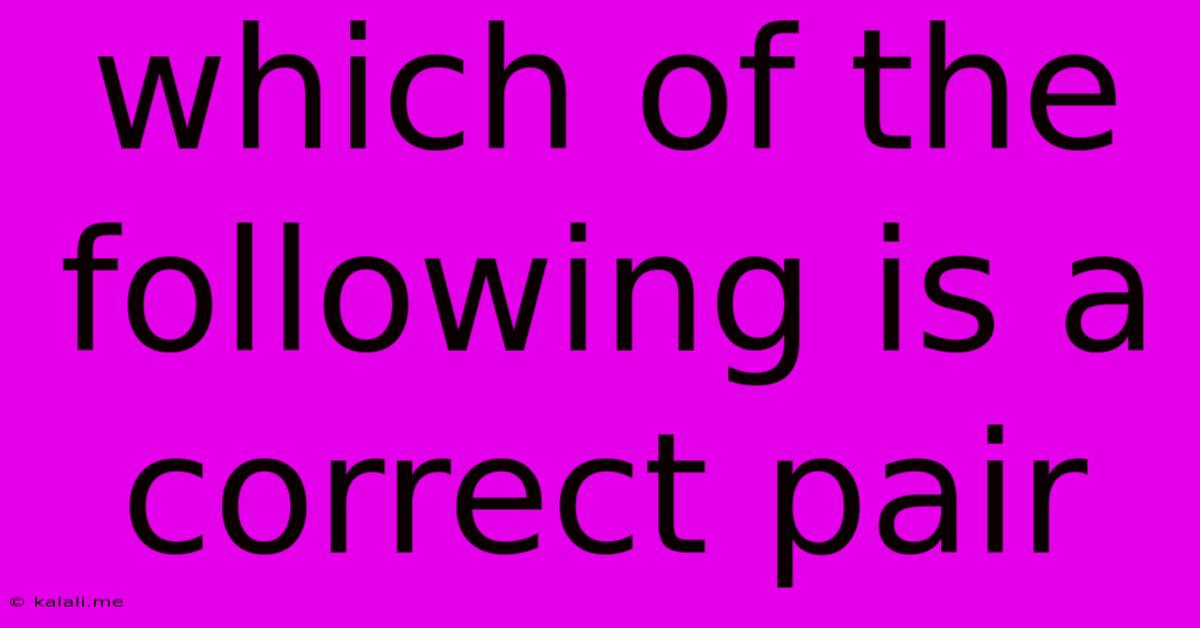Which Of The Following Is A Correct Pair
Kalali
Jun 14, 2025 · 2 min read

Table of Contents
Which of the Following is a Correct Pair? A Guide to Identifying Accurate Relationships
This article explores the crucial skill of identifying correct pairings, a fundamental concept across various fields, from science and technology to language and logic. We'll delve into strategies for analyzing pairings, understanding the underlying relationships, and ultimately determining which pairings are accurate and which are incorrect. This is essential for problem-solving, critical thinking, and making informed decisions.
Understanding the Nature of Pairings
Before we tackle specific examples, let's clarify what constitutes a "correct pair." A correct pair implies a logical, factual, or defined relationship between two elements. This relationship can be based on various criteria, including:
- Cause and Effect: One element directly causes or influences the other. For example, "increased rainfall" and "flooding."
- Synonymity: The elements have similar meanings or functions. For instance, "happy" and "joyful."
- Antonymity: The elements represent opposing concepts. An example would be "hot" and "cold."
- Part-to-Whole: One element is a component of the other. "Wheel" and "car" represent this relationship.
- Association: The elements share a common connection or context, though not necessarily a direct cause-and-effect relationship. "Shakespeare" and "Hamlet" fall under this category.
Strategies for Identifying Correct Pairs
Analyzing pairings requires careful consideration of the context and the relationships between the elements. Here are some effective strategies:
- Define the Relationship: First, identify the type of relationship expected between the paired elements. Is it a synonym, antonym, cause-and-effect, etc.? Understanding this will guide your analysis.
- Consider Context: The context in which the pairings are presented is crucial. The meaning of a pair can change dramatically based on the surrounding information.
- Analyze Each Element Individually: Before evaluating the pair, examine each element independently to fully understand its meaning and characteristics.
- Look for inconsistencies: If a pair doesn't logically fit the established relationship or context, it's likely incorrect. Inconsistencies should be flagged immediately.
- Eliminate Incorrect Pairs: Start by eliminating pairings that are obviously incorrect. This helps narrow down the options and focus on more subtle relationships.
- Verify with External Resources (When Applicable): For factual pairings, consulting reliable sources can confirm the accuracy of the relationships.
Examples of Correct and Incorrect Pairs
Let's illustrate with some examples:
Scenario 1: Animal and Habitat
- Correct Pair: Lion - Savannah
- Incorrect Pair: Penguin - Desert
Scenario 2: Synonyms
- Correct Pair: Large - Huge
- Incorrect Pair: Happy - Sad
Scenario 3: Chemical Compounds
- Correct Pair: H₂O - Water
- Incorrect Pair: NaCl - Sugar
Conclusion
Identifying correct pairings is a skill honed through practice and careful analysis. By understanding the types of relationships involved, employing effective strategies, and critically evaluating the elements, you can confidently distinguish accurate pairings from inaccurate ones. This ability is valuable in numerous contexts and forms a cornerstone of effective problem-solving and decision-making. Remember to always consider the context, define the relationship, and verify your answers when possible.
Latest Posts
Latest Posts
-
University Of Kent Uk Acceptance Rate
Jun 14, 2025
-
Difference Between Primary Key And Unique Key
Jun 14, 2025
-
Which Of The Following Is A Landlocked Country
Jun 14, 2025
-
According To Machiavelli The Ideal Form Of Government Was
Jun 14, 2025
-
Average Act Score For University Of Minnesota
Jun 14, 2025
Related Post
Thank you for visiting our website which covers about Which Of The Following Is A Correct Pair . We hope the information provided has been useful to you. Feel free to contact us if you have any questions or need further assistance. See you next time and don't miss to bookmark.